
Background information
Panasonic Z95B: an OLED revolution with tandem technology?
by Luca Fontana

Two OLED layers, double the brightness and lots of colour: LG's G5 is supposed to do everything better than its predecessor. Sounds like marketing? Perhaps. But will it outshine it in practice?
Full Disclosure: The TV, the 65-inch version of the G5, was provided to me on loan by LG for testing. However, LG has no influence on the test result, my evaluation and the test procedure.
A new generation of OLED beats at the heart of the G5: the RGB tandem panel. Sounds technical at first. And it is. But above all, it's a real technological leap - one that leaves even die-hard OLED fans like me in awe for a moment.
In contrast to classic WOLED panels, LG uses two organic light layers in the G5 - both with their own red, green and blue subpixels - which are placed on top of each other like two transparent screens. Together, they produce a significantly stronger and purer image. This so-called «tandem structure» has several advantages:
For you, this means above all stronger blue, richer green and cleaner red - with less «white-wash» in between. Because even though a white subpixel still contributes to the brightness, it muddies the colours much less than in previous generations.
The result is an OLED TV with a noticeable increase in brightness and colour gamut, even if it doesn't quite match the almost outrageously pure colours of a QD OLED. Nevertheless, compared to the panels that LG uses in its slimmed-down but cheaper C series, the G5 looks like a colour TV in a world full of black and white devices.
Time to find out whether the picture delivers what the technology promises.
If you're wondering what the «G» in the G5 stands for, you'll get a clear answer at first glance at the design: «Gallery». Because the G5 is not just a television, it is a mural with a plug. And one that - in typical Gallery design - doesn't get thinner towards the top, but measures a slim 2.5 centimetres across the entire surface.
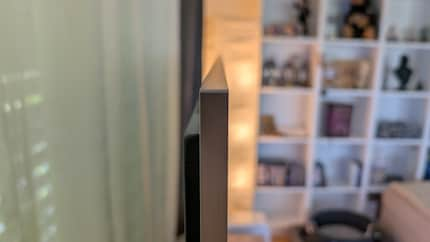
As in the previous year, LG now supplies either a stand or a wall bracket with the 55- and 65-inch sets, depending on the model name:
Those who opt for the larger version - i.e. 77 inches or more - no longer have a choice: the G5 only comes with a wall mount in these sizes. Full stop. If you still want to place the XXL model on a sideboard, you will need to purchase the matching special stand separately. This is not only more expensive, but also looks bulkier than the elegant, flat base of the smaller models. No wonder: with so much screen, you need a base that won't tip over when the wind blows through the living room.
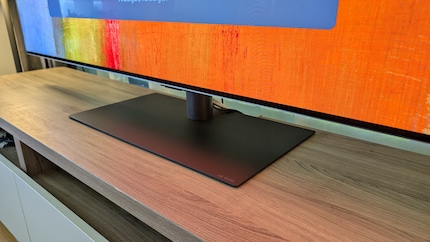
About the sideboard: there is exactly 8 centimetres of space between the bottom edge of the TV and the furniture. That's enough for most soundbars. There's just one thing to bear in mind: the base protrudes about 10 centimetres forwards. So if you want the soundbar and TV to be flush, the piece of furniture must be correspondingly deep. You can see this clearly in the picture above.
Other than that, LG remains true to its simple style: narrow edges, an elegant aluminium frame and a back that can be hidden just as easily as the cable management in the stand. The latter guides the cables directly down through the back - almost without a trace if you look at it from the front.
Technical connections and features:
All four HDMI inputs of the G5 support HLG, HDR10 and Dolby Vision. The latter even together with Filmmaker Ambient Mode. HDR10+ is missing - a pity, but bearable. The standard is exotic and almost only appears in individual titles on Amazon Prime Video. For now, at least.
The pass-through function for Dolby Atmos is also a positive feature. This means that the TV passes multi-channel sound cleanly to your sound system - for example, if you have a Blu-ray player or set-top box connected. However, LG no longer supports pass-through for DTS formats for its entire 2025 line-up. A surprising decision that I can't understand, as there are still many Blu-ray discs with a DTS soundtrack. Too bad, LG.
What comes next goes deep into the matter. I measure with professional tools from Portrait Display to get an objective classification of the picture quality. If you are not interested in details and diagrams, you can read the following short version and then scroll to the chapter «The image: colour rush with sensitivity».
The most important findings in brief:
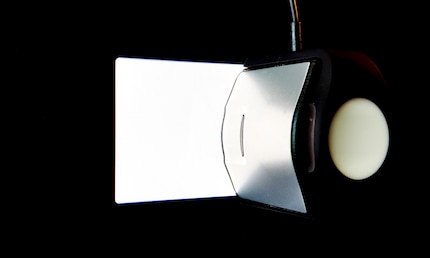
About the measurements: I measured all of the TV's screen modes without calibrating it - just as it came out of the box. I therefore hardly made any changes to the settings:
The «Dolby Vision Filmmaker Mode» achieved the best measured values for all types of content. I therefore strongly recommend always activating filmmaker mode for both SDR and HDR content. Except for gaming. Regardless of my measurements, you should always use gaming mode. This is due to the low input lags there.
Apropos: Are you looking for a good TV for gaming? You can find my guide article here:
In my measurement, the LG OLED G5 achieved a peak brightness of 2350 nits in the 10 per cent window - this is a new best value for OLED televisions in my test laboratory. Even in the particularly small 2 per cent measurement window, it is still an impressive 2300 nits. These values not only mark a clear improvement on the G4 from the previous year (1421 nits), but also surpass Samsung's QD OLED S95D (1627 nits), which was previously considered one of the brightest OLEDs.
In comparison, the Philips OLED 809 is shockingly subdued at 906 nits - solid for the mid-range, but still in a different league.
What is particularly noticeable: Even with larger image sections, the G5 remains comparatively bright. In a 100 per cent white image - i.e. with a completely white screen - it achieves an incredible 380 nits. This is more than all other OLEDs in the comparison field and indicates that LG's new RGB tandem technology not only works efficiently with punctual brightness, but also across the entire surface.
Just as pleasing is the fact that no noticeably aggressive ABL (Automatic Brightness Limiter) was evident during everyday television, HDR streaming and even when playing «EA FC 25» for long periods of time. In other words, the picture remains stably bright, even with bright menus or dynamic gameplay. No sudden dips in brightness, no readjustment, just an OLED that remains consistently bright when required.
In short, the G5 is the brightest OLED TV I have tested to date. It also feels that way in everyday life. Even friends who were over for a series evening once said: «Ui, is it just us, or is the TV a bit dazzling?»
What seemed unthinkable just a few years ago is now a reality: an OLED that dazzles.
Let's take a look at how well the LG OLED G5 displays white, colours and shades of grey. In other words, everything that makes a picture look natural. Three questions will help:
Each of the 8.3 million pixels in the LG OLED G5 consists of two superimposed white, red, green and blue sub-pixels (tandem structure). White is created when they all radiate at the same time and with the same intensity. Full brightness therefore produces the brightest white. The lowest brightness, on the other hand, produces the darkest white. Or rather: black. In between are shades of grey of varying brightness. This is why the English term "grayscale measurement" is used.
The greater the difference between the brightest and darkest pixels, the better the contrast values. As with all my OLED TV tests, I don't measure contrast because OLED pixels can switch off completely. This means that the contrast ratio tends towards infinity anyway.
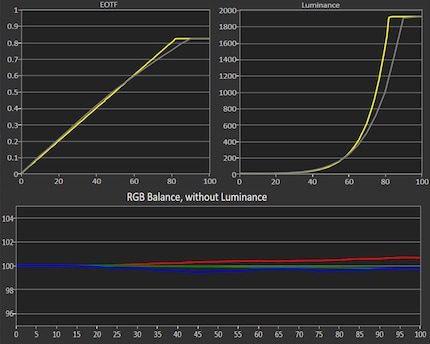
The EOTF measurement of the LG OLED G5 in Dolby Vision cinema mode shows a very clean gradation of grey levels overall. Up to around 80 per cent brightness, the measured line follows the reference exactly - only in the highlights is the measurement slightly lower. This means that very bright grey tones appear slightly darker on the G5 than they should.
The luminance curve confirms this: at around 1865 nits, the G5 comes close to the target maximum brightness, but falls just short of it from around 80 to 85 per cent brightness. This is probably a deliberate mapping to better control highlights and avoid clipping - i.e. the abrupt cutting off of details in very bright image areas.
Now to the measured colour balance with brightness:
The RGB balance without luminance is almost perfectly in line. There is no significant colour cast to be seen. With luminance, the balance drops evenly from around 65 per cent brightness, especially at 80 to 90 per cent. The picture becomes darker there, but not discoloured.
In short: LG delivers a very precise out-of-the-box calibration with minimal weaknesses in the upper brightness levels. Those looking for perfect highlights will see differences here, but only in direct comparison with a real reference monitor.
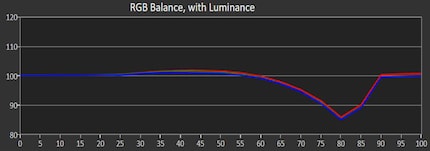
On the topic of colour space coverage, the LG OLED G5 delivers very good values - especially for a WOLED panel:
What does this mean in practice? As long as you watch the latest HDR content, which is practically always the case with Dolby Vision, Netflix, Disney+ and the like, the G5 is an excellent choice. The colours look vivid, rich and nuanced. Only with extremely colour-intensive content or future formats with an extended colour space could differences to a QD OLED TV become apparent. And even then, probably more in a direct comparison.
One point clearly speaks in favour of the G5, however: the colour gamut at high brightness levels. Especially in comparison to the G4, its predecessor. Thanks to the tandem technology, the G5 also creates rich colours with punch in bright scenes. With this, LG gets the last ounce out of the WOLED technology; only absolute perfectionists or colour grading professionals will notice the difference to a QD OLED TV.
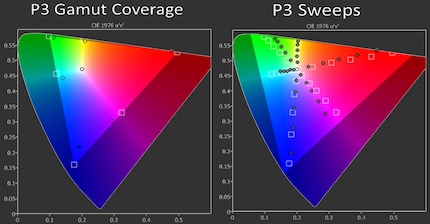
Let's move on to the last discipline: colour fidelity. In other words: How accurately does the TV match the colours that it should actually show according to the signal? The deviation from the TV to the reference value is referred to as DeltaE (dE). The white boxes (see above) show the reference colours sent to the TV by the test pattern generator, the black circles show the colours actually measured.
The LG OLED G5 achieved an average DeltaE of 2.29 in the tested Dolby Vision cinema mode - a very good value that can hardly be surpassed without a reference device. However, a closer analysis reveals that warm colours such as red, yellow and orange are not perfect. As a result, the picture sometimes appears slightly too cool, especially with skin tones or warm light. There are no major errors, but the colour mapping is not always completely clean.
In concrete terms, this means that the colours make a vivid, strong impression. Especially with HDR content, the rich tones really catch the eye. However, if you look very closely or place a reference device next to it, you will notice that individual nuances are not quite accurate. The last bit of precision is sometimes missing, especially with warmer colours.
For everyday use, this hardly matters: the image looks harmonious and intense. But if you value colour fidelity above all else or even want to use the display for professional grading, it's better to go for a QD OLED screen, which is a little more accurate in this discipline.
Reflections are not measurable per se. Nevertheless, it's worth taking a look - after all, who always watches in a home cinema at zero lux? The G5 shows that LG does an excellent job with its anti-reflective coating. Direct light sources such as windows or lamps are significantly reduced. The glass appears darker, reflections become less harsh without being diffuse across the entire screen. And the image remains clearly outlined, even in daylight.
Only in very dark scenes (below: «Blade Runner 2049») do selective reflections stand out a little more - sometimes as slight banding or fine light spots. But even then, the effect is limited. Thanks to the very high peak brightness, the G5 easily outshines most light sources.
In short: An OLED TV that hardly reflects even in daylight and masters bright environments with ease. A few years ago, that would have been science fiction. Currently, I only see Samsung's QD OLED TVs with a matt coating as superior in this discipline.
Let's move on to the practical test. This time, I'm particularly interested in the direct comparison between LG's new OLED G5 and its predecessor, the G4. The latter caused quite a stir last year with its microlens layer (MLA): Thanks to microscopically small lenses that focus the light of the OLED pixels specifically to the front, the G4 achieved unusually high brightness values for a WOLED panel.
The G5 now takes a different approach. As a reminder: instead of microlenses, LG has opted for a new tandem panel with two WOLED layers on top of each other. This should not only ensure more brightness, but also richer colours, better efficiency and a longer service life.
I also use Samsung's QD OLED technology as a comparison. Although this only uses a single OLED layer, it combines this with a quantum dot layer that converts the light into particularly pure and bright colours - often a visible advantage, especially with HDR content.
When it comes to crisp colours and sophisticated contrasts, there's no way around «Guardians of the Galaxy, Vol. 2» for me. The scene in Ego's palace is particularly exciting: glowing red lighting, rich green, lots of metallic surfaces - exactly what OLEDs have to be measured against.
This is where the LG OLED G5 shows what the new tandem panel can do. Compared to the G4, the picture appears even more balanced, especially in the transitions between strong colours and dark areas. In a direct comparison, the G4 tends to be a little too aggressive in terms of colour, while the G5 achieves a visibly better balance between bright orange and natural colour reproduction. The dark areas also appear slightly punchier without swallowing up details.
Quelle: Disney+, «Guardians of the Galaxy, Vol. 2». Timestamp: 00:56:47.
The G5 also makes a very strong impression in comparison to Samsung's QD OLED televisions. The picture appears warmer, more pleasing and subjectively I even like it a little better. Perhaps this is just the classic recency effect. In other words, the fact that what you last saw remains particularly positive in your memory. Because objectively speaking, Samsung's S95D is still the top dog when it comes to colour fidelity: no TV in my tests so far has come closer to the reference values.
And yet: While Samsung's colours appear more sober and grounded - almost documentary natural - LG stages the picture more emotionally, with a little more warmth and punch.
To complement this, I also watched «Avatar: The Way of Water», a film that is perfect for colour comparisons with its intense blue and green tones.
In a direct comparison with the G4, the G5's image appears more powerful, with more punch - especially with rich greens. The jungle scenes are a little more vibrant, the Na'vi blue looks richer without appearing artificial. There is also a difference compared to Samsung's S95D: while Samsung scores again with its natural colouring, LG relies on more intensity. This is particularly suitable for a visually opulent film like «Avatar».
Whether one is better than the other? I don't want to give a definite answer. But if you value maximum colour precision, you should still go for the S95D.
Quelle: Disney+, «Avatar: The Way of Water». Timestamp: 00:48:10.
The scene from «Skyfall» in which Bond and Q stand in front of an old warship in a museum is the best way to judge how natural a picture looks. Soft light, muted colours and lots of skin tones - ideal for seeing how a TV handles faces, fabric textures and the lighting environment.
Subjectively, I like the picture of the G5 best here. The skin tones appear warm, but not exaggerated, but pleasantly vivid. The balance between naturalness and slight warmth is exactly to my taste: faces look healthy, not pale, but not embellished either.
Lens-wise, however, Samsung once again delivers the most neutral picture with the S95D. The colouring is slightly cooler, but extremely precise and restrained. Those looking for maximum naturalness without visual amplification will find what they are looking for here. LG, on the other hand, has opted for a gentle, emotional tuning in the G5, which gives the image a light, pleasing character.
Quelle: Apple TV+, «James Bond – Skyfall». Timestamp: 00:39:02.
Both approaches work. One more sober, the other with more charm. As is so often the case, which visual philosophy you like better is a question of personal taste.
How well does the LG OLED G5 master dark film scenes? For this test, I chose the beginning of «Blade Runner 2049». Backlighting, silhouettes, minimal light sources - just the right set-up to assess black crush and loss of detail in shadow areas.
In the first shot, the G5 visibly swallows up more detail than the G4 and S95D. Fine structures are lost, especially in the face of the replicant played by Dave Bautista. Is that a bad thing? Not necessarily. Backlit scenes like this are deliberately designed to visually swallow up details in the shadows - for artistic reasons. I've seen tech demos where manufacturers have proudly shown how their LCDs can use AI to pull every last bit of texture out of dark corners. The result: a flat, unnaturally brightened image that loses all mood.
The reverse shot is exciting: Here, the G5 appears more balanced than both competitors. Dark areas of the image remain rich and contrasty, while light sources stand out brightly, clearly and in great detail. A nice balance of dynamics, depth and controlled detail. For me, one of the greatest strengths of the G5 in the practical test.
Quelle: UHD-Blu-Ray, «Blade Runner 2049». Timestamp: 00:04:50.
At the end of the image test, I take a look at the display of fine gradations in particularly bright image areas. The appropriate scene for this comes from «Jurassic World»: a low sun that bathes the sky in bright orange. Ideal for seeing how well a TV handles strong light sources and their fine colour gradients.
And yes, the G5 performs excellently here. The sun remains visible as a clearly defined sphere without burning out or blurring as a white spot. There are soft colour gradients all around, where condensation trails and the subtle tones of the sky are preserved.
Quelle: UHD-Blu-Ray, «Jurassic World». Timestamp: 00:21:18.
In a direct comparison, the G5 actually appears the most differentiated. Bright HDR peaks in particular show how well LG's tandem panel can handle high luminance levels - without sacrificing detail. A discipline in which the G5 not only doesn't have to hide from the G4, but also performs even better.
The processor is the centrepiece of every TV - or, if you believe LG, half a research laboratory in chip form. The G5 uses the Alpha 11 Gen2 4K AI processor, which doesn't sound bulky at all and is a kind of all-rounder with superpowers according to the manufacturer: it is said to upscale content to 4K, recognise objects with pixel accuracy, optimise colours and brightness and bring every image to life thanks to «AI Picture Pro» « » .
There are also terms such as «AI Perceived Object Enhancer», «OLED Dynamic Tone Mapping» and «Brightness Booster Ultimate» - a buzzword buffet that should bring tears to the eyes of even Apple's head of marketing.
But beyond the buzzword buzz, the exciting question remains: What does the chip really do with the image? Let's take a look at it.
Time for the classic Judder test, where I want to observe the fine judder during smooth camera pans. The scene in the barn from «1917» is perfect for this: slow movement, lots of vertical lines, everything it takes to trip up a poor processor.
Quelle: UHD-Blu-Ray, «1917». Timestamp: 00:42:25.
LG's G5 remains completely unimpressed. With the second generation of the Alpha 11 processor, the panel displays a wonderfully smooth picture without any jerks or jitters. As a reminder: I set the TruMotion option to «Natural picture» in the settings at «Clarity». For me, this is the perfect compromise between smooth and without a soap opera effect.
I hardly see any difference compared to the G4. LG was already strong in this discipline last year - and remains so. Samsung's S95D also performs excellently. Minimal differences, if any, are only visible on very close inspection.
We continue with a particularly demanding scene from «1917». The camera slowly moves around two soldiers in the forest, their helmets in the foreground, blurred branches and shimmering treetops in the background. Such transitions in particular show how well a processor handles movements and edges.
Quelle: UHD-Blu-Ray, «1917». Timestamp: 00:35:36.
Once again, I hardly see any differences between LG's G4 and G5. Both master the scene with impressive aplomb. If I look closely, the G5's image appears slightly sharper in the contours, especially around the helmets. The movement remains stable, without ghosting or visible artefacts.
The comparison with Samsung's S95D shows a similar picture. Here, too, the image is very good, but LG manages to draw the edges around moving objects a touch more precisely. It's not a huge difference, but one that can be quite noticeable depending on the content.
Next up is the response time of the pixels. The opening scene of Episode 5 from «For All Mankind» is suitable for this. The camera slowly pans across the surface of the moon while text appears in the bottom left-hand corner. Moments like this show whether the pixels switch quickly enough or whether they leave visible streaks.
Quelle: Apple TV+, «For All Mankind», Staffel 1, Episode 5. Timestamp: 00:00:10.
None of this can be seen on the LG G5. The superimposed texts remain razor-sharp, even when moving slowly over high-contrast backgrounds. As is typical for OLEDs, the pixels react extremely quickly, which virtually eliminates ghosting effects. Samsung's S95D also shows no weaknesses in this discipline.
I used an older mini LED TV for comparison: TCL's C82 from 2022, where the streaks are clearly visible. LCD televisions are usually at a disadvantage in this respect. This is why OLEDs, not LCDs, are considered exquisite console gaming monitors.
Let's move on to the most subtle part of the picture test: upscaling. In other words, the question of how well a TV can convert low-resolution content into a clean 4K picture. As always, I use «The Walking Dead», season 7, episode 1. Shot on 16 mm film, deliberately rough and grainy to emphasise the apocalyptic mood - just the thing for watching a processor at work.
Quelle: Netflix, «The Walking Dead», Staffel 7, Episode 1. Timestamp: 00:02:30.
The LG G5 performs strongly as usual. LG's Alpha 11 processor has been known for years to effectively reduce image noise without flattening details. The image on the G5 is also sharp, looks rich and at the same time pleasantly natural. The dark areas between the two hostile men remain calm, without noticeable artefacts or coarse noise.
In contrast, slight impurities such as fine noise and compression residue are somewhat more present on Samsung, although I tried to increase the noise suppression in the settings. Nevertheless, the picture remains good, but not quite at LG level.
On the topic of input lag: With the measuring device from Leo Bodnar, I measured an average input lag of 9.7 milliseconds with a UHD image at 60 frames per second and HDR enabled. This is a very good value and on a par with the LG G4 - which achieves 9.8 milliseconds. The value is also below the 20 milliseconds that a game mode should achieve.
Apart from this, the TV supports all features relevant for gamers:
To this end, LG, along with Sony, Philips, Panasonic, TCL and Samsung, has entered into a partnership with major gaming studios. The result is the HGiG - the HDR Gaming Interest Group. According to the manufacturer, the aim is to ensure that HDR is displayed as intended by the game developers, for example when playing «Spider-Man 2» on my PlayStation 5.
Quelle: PS5 Pro, «Spider-Man 2», variabler 120Hz-Modus, HDR, VRR und Ray Tracing aktiviert.
What the LG OLED G5 achieves in gaming mode is top class. I whizz through virtual worlds at 120 frames per second, steer precisely through hectic battles and experience a gaming experience that feels extremely direct. The input lag is so low that every action is immediately realised on the screen. No waiting, no delay, no feeling of distance between controller and game.
The picture quality is also impressive across the board. Colours are intense and rich without being exaggerated. The deep black of the OLED panel gives dark scenes a believable depth, while explosions, light reflections and fast movements remain razor-sharp. Even with rapid camera pans or quick changes of direction, the picture remains stable and clear.
In short: Game Mode is simply fun.
LG has made AI the big topic of its 2025 OLED TVs. This is because all new models are equipped with Microsoft's Copilot - a powerful voice model that, in combination with the new microphone button on the remote control «, is designed to activate LG AI».
The idea sounds promising: instead of rigid voice commands, you should be able to tell the TV naturally what you are looking for - such as «the action film with the guy in the white shirt and the exploding skyscraper». And the TV should not only understand you, but also tell you where you can stream, buy or rent the film. Sounds almost too good to be true.
Unfortunately, it was.
What can I say? It was the purest break. The TV didn't understand «Which actors are you watching?», nor «Where can I find the network settings?», nor «The picture is too bright, what can I do?» Instead, I got useless YouTube videos, error messages and helpless dialogue boxes. And sometimes the voice control just started by itself. Why was that? I have no idea. Maybe my fridge was coughing.
After a few attempts, I gave up and switched off the would-be smart voice control. I operate the TV with the remote control not only faster, but also more intelligently than it operates itself.
The LG OLED G5 is what happens when technology is not only further developed, but also consistently rethought. The tandem panel brings measurably more brightness, visibly better colours and noticeably more punch to the picture - without losing the typical OLED finesse. Whether HDR, gaming or series marathons: the G5 plays at the top in almost all disciplines.
Two things slightly spoil the picture. Firstly: DTS passthrough is missing - and that's not just a pity, it's simply incomprehensible to me. Half a star is deducted for this. Secondly, the new voice control is a break. But to be honest, it already was before. I've never operated my TV by voice before, so I'm not "losing" anything and I don't see any reason to start now.
The bottom line is that the enthusiasm clearly outweighs the inconvenience. And because half a star can't be displayed up there (no idea why, by the way), I'm rounding up. Five out of five stars. Well deserved.
Pro
Contra
I write about technology as if it were cinema, and about films as if they were real life. Between bits and blockbusters, I’m after stories that move people, not just generate clicks. And yes – sometimes I listen to film scores louder than I probably should.